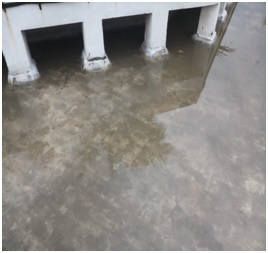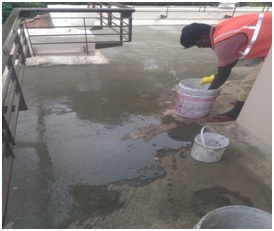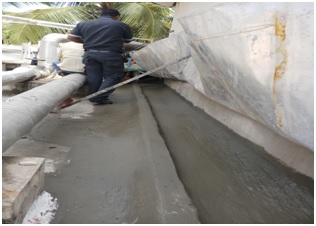Leakage is always typical by nature though it ends up in permeation of water or any liquid or gas through or between surfaces. If we take leakage of water as a case study in the construction industry it is at-least in India considered that waterproofing is C grade activity and most of the contractors overlook or never carry out this activity. This could be due to negligence or to save money or due to overconfidence. Whatever may be the reason leaks have made all of us invite ourselves to LEAK-AGE.


Fig 1 – Labours preparing the terrace for waterproofing to prevent leakage
The typical areas of leakage are not necessarily rooftop, it can be sunken portion or rooftop garden. It can also be a general water holding body or water running body. Source for water penetration can be the tile itself which is the least suspected area. The water penetration through tile is immanent as we get imitated tiles which are either cheap or ready to cheat.



Fig 2 – Surface Preparation for waterproofing caused due to leakage
Classification of leakages;
In general, if we are talking about leakage we can classify it as sweating, dropping, dripping, flowing and oozing. Sweating or scaring takes place as an initial symptom and is followed by other process. Oozing takes place mostly in case where water table is high. For thumb rule, one can consider water coming out anywhere in the vicinity of 21 meters from the source of an inlet in the normal course. It can be even more if it gets support or guide to flow further. Under pressure, it can leak anywhere to a height of 4 feet from the surface of travel.




Fig 3 – Identifying cracks which occurred due to leakage at the project site
Dilemma faced by user, client , consultant and promoter for addressing leakage issue
There are different situations we can come across as a user, client, consultant, promoter (trader/manufacturer) As a client there is general the notion that he knows everything, which to some extent is true as he would have googled information or would have heard and say they get carried out by jargon and make them prey. As a promoter, he always likes to confuse or corrupt as in most of the cases instead of convincing which demands some information about the products which invariably they do not have. But most of them will be successful in promoting products since contact is known to them or consultants.
In a rare situation, the products are selected based on performance and in these cases they will have to undergo more than required tests and humiliation as there will be a dedicated system which tries to fail the product or system. But once we are successful, it is easy to get repeat orders as products will speak by it.




Fig 4 – Workers assessing and applying necessary steps for leakage prevention
The identification of source product selection of waterproofing to stop leakage
Identification of source product selection and surface preparation will assist to do 85% of the waterproofing job rest lies in the application. Grouting has been considered as an all-time solution, but it is not apt for old surfaces and lean structures. The reason is vibration, which will weaken the structure or either drift the leak point or give temporary relief. Grouting can be the solution for multi-layered structures and cannot be used everywhere.



Fig 5- Curing the leakage affected area by water stagnation method
There is a situation where both consultants and owners get carried away by jargon and solution providers, and are put into an embarrassing situation where they will be made to adopt process and products that just camouflage the problems and not solve them. There can be a situation where the slab is cracked due to exothermic reaction and is growing due to non-quenching activity but contractors are asked to waterproof without being allowed to understand and salvage the problem. Coatings under such situations can camouflage problems but once it gets punctured the leak persists. Minor cracks can be covered using resins of Epoxy or PU or even sodium silicate mixed with chalk powder instead of grouting anywhere everywhere. Pressure grouting can be further trouble creator due to withering action than a problem solver. Therefore, knowing, what to apply where becomes pivotal.
Different form of leakages
Leakages are of different form and it starts from scar, wetness, sweating, dripping and flowing.
A scar can be misleading due to the urgency and if wall putty is applied over the wet surface then it looks like leakage but it is not. Under such situation blow torch is used to dry the surface that can be devastating as it will dehydrate wall plaster also and lead to cracking. Right thing is to wait for the surface to dry and then apply putty and paint if the damage is done then allow it to lose the sheen due to natural heat and light (including lights normally used in the premises). If a scar is due to water presence then it will slowly expand or diminish and improve leading to sweating, dripping and flowing some time even oozing or spring.





Fig 6 – Inspecting leakage at the project site by our staff
Different processes and products to reduce leakage
If the water leakage is due to surface cracks in tiles etc., then impregnation is the best way as the process aids to get into the surface and arrest the leak. Impregnation is nothing but grouting by gravity where the liquid will displace air and Vick inside might even come out of mother surface even though it a slab. Vicking is possible even in lateral movement and also downwards. Lateral movement will not be for a much distance but downwards can be more than 32 inches ie, where ever water travels this will go along with water and seal from reverse, once liquid content gets decimated by either getting absorbed by concrete or available material. Once this happens it will also augment the strength of the surface as it would have filled the voids. The water collected before will exit downward over, some time say 4-6 weeks depending on water collected earlier over a while.
The advantage of this process is that it can work on wet surface and tiled surface or claded surface thereby saving time and money and still get the result. This can also be used whenever water is coming out in pressure, say close to 20 liters per hour. The application process for such situation will vary depending on site condition.
The limitation of this product is that it can be used only where cement used is a white or grey cement PPC or OPC. The advantage of this product is that by varying proportion and consistency, it can be used on all WATER RUNNING AND WATER HOLDING BODIES SUCH AS INTEGRALS, COATING, and LAMINATE, IMPREGNATE. This has heat and U V resistance property apart from crack resistance. AKWOSHIELD is one such product which is unique till now.
Coatings are good on porous surface and also when the surface is properly prepared.




Fig 7 – Coating being applied on the leakage affected areas by our workers
This, when applied over non traffic areas, will be in a stay put condition and will not allow leakages. There are exceptional coatings like epoxy or pu or polyurea , which are good for waterproofing for some lower derivatives. These are also available in the market which sounds economical but not as effective as it is supposed to be. Notably if the coating gets damaged, then the leak starts as they form top layers and not integrate deep into the structure.
Superior grades which have higher face value defies all above statements and can be even be used underwater in presence of water, say in dams like situation and moreover the leaks can be arrested effectively. There are coatings which can be used even as grouts, coats or sprays depending on surface and site situation.





Fig 8- Depending on the surface and end requirement different coatings are used for waterproofing for leakage prevention
The coatings have different bases like cementitious, lime, acrylic, silicone, epoxy, polyurethane, polyurea. Cementitious and lime. These are time tested and long-lasting. These are also effective and economical. Acrylics are brittle and silicone has a low peel strength. Depending on the surface and end requirement it is commonly used for waterproofing.
Epoxy is solvent based or solvent-less and bitumen based. Each one has its own advantage. When it comes to eco-friendly concept, solvent-less epoxy is the best and will have no smell. This also have less voc.





Fig 9 – Waterproofing activities at different at different projects for leakage prevention
Epoxy can be used on surfaces which are hard and clean free from dirt grease water and foreign materials. It needs 72 hours for chemical curing and 14 hours for traffic movement. There are three stages of of this process- curing tack dry, green stage and grey stage which is final. There are also more advanced epoxies which can be used underwater or quick setting like touch dry etc. But we are talking about general epoxies which are used for waterproofing conventionally. Epoxies can be used on surfaces like wood, concrete steel, and glass structures apart from metal shingles, etc., It can also be used on flooring where there will be traffic too.







Fig 10 – Identification of crack location caused by leakage and the cracks are repaired in a step by step process.
Conclusion
A lack of appropriate leakage investigation and monitoring can result in repairs that are unsuccessful in controlling or reducing leakage. Water leakage has become an important issue and needs to be analysed correctly. It has become important to know the process which suits your project requirement. This has become common in most of the case and maybe this is why one of the magazines in recent past had mentioned 95% buildings are leaking in India. This may not be a fact but expresses the gravity of the situation.
Author:- Dr. (HC) S. B Raghunath from Protect Group

